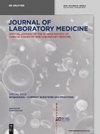Results of using Luer-Lok access device for clinics, intensive care units, and emergency services with high pre-analytical errors: analysis of 491.850 samples
IF 1.1
4区 医学
Q4 MEDICAL LABORATORY TECHNOLOGY
引用次数: 0
Abstract
Abstract Objectives The effectiveness of the Luer-Lok™ Access Device (LL) with the intravenous catheter (IVC) on sample rejections, which is used to prevent primarily hemolysis in the emergency department (ED), clinics, and intensive care units (ICU), was examined. Methods A total of 491.850 samples of eight months from Amasya University Sabuncuoğlu Şerefeddin Training and Research Hospital were investigated retrospectively. Inpatient, intensive care unit and emergency department samples were included in the study. Pre- (BLL) and post-Luer Lok (ALL) rejection of the samples analyzed. In the BLL period, 3,463 rejection samples out of 253,818 (1.36%) in the September-December period of 2020; in the ALL period, 1819 rejected samples from 238,032 (0.76%) in January-April 2021 were analyzed for all reasons. Results It was determined that the use of LL significantly reduced all-cause sample rejections. In addition, a significant decrease was observed in the rates of hemolysis and clot-related rejection thanks to LL. Conclusions According to our study data, in patients with IVC with the LL device, the pressure brought by the syringe is mainly avoided, and reliable blood collection is achieved, similar to the routine vacutainer blood collection apparatus, and hemolysis- and clot-related sample rejections are largely prevented.分析前误差较高的诊所、重症监护病房和急诊使用Luer-Lok接入装置的结果:分析491.850份样本
摘要目标Luer Lok的有效性™ 在急诊科(ED)、诊所和重症监护室(ICU),使用带有静脉导管(IVC)的样本排斥接入装置(LL)主要用于预防溶血。方法对Amasya大学SabuncoğluŞerefeddin训练研究医院8个月的491.850份样本进行回顾性调查。研究中包括了住院病人、重症监护室和急诊科的样本。分析的样品在Luer-Lok(ALL)前(BLL)和后(ALL)拒收。在BLL期间,在2020年9月至12月期间,253818份拒绝样本中有3463份(1.36%);在ALL期间,分析了2021年1月至4月238032份(0.76%)中1819份因各种原因被拒绝的样本。结果LL的使用显著降低了全因样本拒绝率。此外,由于LL,溶血和血栓相关排斥反应的发生率显著降低。结论根据我们的研究数据,在使用LL装置的IVC患者中,主要避免了注射器带来的压力,实现了可靠的血液采集,类似于常规的真空采血仪,并在很大程度上防止了溶血和血栓相关的样本排异。
本文章由计算机程序翻译,如有差异,请以英文原文为准。
求助全文
约1分钟内获得全文
求助全文
来源期刊

Journal of Laboratory Medicine
Mathematics-Discrete Mathematics and Combinatorics
CiteScore
2.50
自引率
0.00%
发文量
39
审稿时长
10 weeks
期刊介绍:
The Journal of Laboratory Medicine (JLM) is a bi-monthly published journal that reports on the latest developments in laboratory medicine. Particular focus is placed on the diagnostic aspects of the clinical laboratory, although technical, regulatory, and educational topics are equally covered. The Journal specializes in the publication of high-standard, competent and timely review articles on clinical, methodological and pathogenic aspects of modern laboratory diagnostics. These reviews are critically reviewed by expert reviewers and JLM’s Associate Editors who are specialists in the various subdisciplines of laboratory medicine. In addition, JLM publishes original research articles, case reports, point/counterpoint articles and letters to the editor, all of which are peer reviewed by at least two experts in the field.
 求助内容:
求助内容: 应助结果提醒方式:
应助结果提醒方式:


